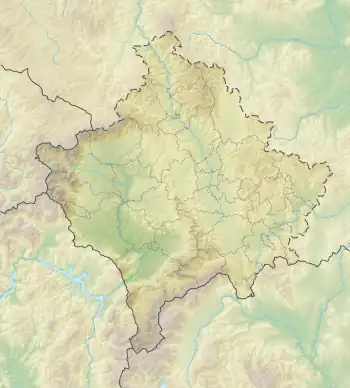Pashtrik
Pashtrik or Pashtrikë (Albanian: Pashtriku) or Paštrik (Serbian Cyrillic: Паштрик), is a mountain located in Kosovo and Albania. Its highest peak is located on their mutual border. It is 1,986 m (6,516 ft) high. The White Drin river passes along by it.[1] Mount Pashtrik is the site of annual pilgrimages of residents from Has region of Prizren and Gjakova in Kosovo and from the border area of Albania.[2]
| Pashtrik | |
|---|---|
| Pashtriku | |
 A view of Pashtrik | |
| Highest point | |
| Peak | Pashtrik |
| Elevation | 1,986 m (6,516 ft) |
| Coordinates | 42°12′38″N 20°31′24″E |
| Geography | |
 Pashtrik Location of Pashtrik on the border of Albania and Kosovo  Pashtrik Pashtrik (Kosovo) | |
| Countries | Albania and Kosovo |
| Parent range | Dinaric Alps |
History
In the 15th century the Albanian toponym Darda was recorded in the region, which indicates an Albanian presence.[3]
Tax register from 1452 show the inhabitants of Darda and the Pashtrik had mostly Albanian anthroponyms.[4]
Overview
Pashtrik is located in the historical region of Has, which up until the 16th century was named after the mountain. In the 17th century the name Has gained a prominence. It is a reference to the taxation status of the region which was taxed directly under the Ottoman Sultan instead of being part of the administrative divisions of the Ottoman Empire.[5] Two-thirds of the mountain belongs to Albania. It is located in north-eastern Albania. The village of Krumë is positioned next to it. One-third of the mountain is in Kosovo. It is located in south-western Kosovo. The village of Gjonaj is positioned next to the mountain. It was built from Paleozoic core, covered by Mesozoic limestone, mostly under the vegetation.
Small mammals living in the mountain include the common vole, northern white-breasted hedgehog, balkan mole, and european mole.[6] The blind mole occurs in the grasslands in old growth stands of beech forest.
Cult and pilgrimages
Mount Pashtrik has been considered sacred since ancient times. The old pagan cult is reflected in the annual pilgrimage of both Christians and Muslims that take place on the mountain.[7] Catholic pilgrimages celebrate a two-day festival dedicated to the Assumption of Mary. The feast is called by locals "Feast of the Holy Trinity" (Albanian: Festa e Shëndritatit). Bektashi take pilgrimages to honor the legendary figure Sari Saltik (Albanian: Sari Salltëk), considering the mountain to contain one of his seven tombs. The Orthodox of Prizren consider the mountain to contain the tomb of Saint Pantaleimon, and take pilgrimages celebrating one whole night in summer.[8]
The cult of the mountain and mountain tops is widespread among Albanians. This ancient practice is still preserved today, notably in Pashtrik, Lybeten, Tomorr, Gjallicë, Rumia, Koritnik, Shkëlzen, Mount Krujë, Shelbuem, Këndrevicë, Maja e Hekurave, Shëndelli and many others. In Albanian folk beliefs it is strictly related to the cult of Nature in general, and the cult of the Sun, the earth and water in particular. Every mountain is said to have its own nymph (Zana e malit). According to the top of the mountain where the nymphs stay, they get their specific name. Therefore Mount Pahtrik is the dwelling of Zana e Pashtrikut.[9]
See also
References
- Marković, Jovan (1990). Enciklopedijski geografski leksikon Jugoslavije. Sarajevo: Svjetlost. ISBN 978-86-01-02651-3.
- Krasniqi 2014, p. 5; Elsie 2010, p. 211.
- Rexha, Iljaz (2016). Registration of settlements and Albanian population on Kosovo. Prishtinë: Institute of History “Ali Hadri”. p. 462.
- Vilajet-pastric-pashtrik-1452-53-godine
- Bardhoshi, Nebin (2011). Gurtë e Kufinit. UET Press. p. 75. ISBN 978-99956-39-22-8. Retrieved 23 March 2020.
- University of Tirana. "Small terrestrial mammals of Albania: distribution and diversity (Mammalia, Eulipotyphla, Rodentia)" (PDF). zookeys.pensoft.net. Tirana.
- Krasniqi 2014, p. 5; Elsie 2010, p. 211.
- Elsie 2010, p. 211.
- Krasniqi 2014, pp. 4–5; Tirta 2004, pp. 75, 113, 116; Gjoni 2012, pp. 62, 85–86.
Bibliography
- Elsie, Robert (2010). Historical Dictionary of Kosovo. Historical Dictionaries of Europe. Vol. 79. Scarecrow Press. ISBN 978-0-8108-7483-1.
- Gjoni, Irena (2012). Marrëdhënie të miteve dhe kulteve të bregdetit të Jonit me areale të tjera mitike (PhD) (in Albanian). Tirana: University of Tirana, Faculty of History and Philology.
- Krasniqi, Shensi (2014). "Pilgrimages in mountains in Kosovo". Revista Santuários, Cultura, Arte, Romarias, Peregrinações, Paisagens e Pessoas. ISSN 2183-3184.
- Tirta, Mark (2004). Petrit Bezhani (ed.). Mitologjia ndër shqiptarë (in Albanian). Tirana: Mësonjëtorja. ISBN 99927-938-9-9.
